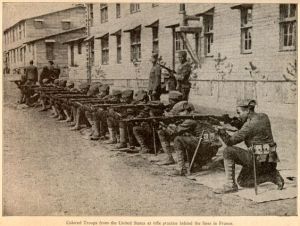
Black Infantry Soliders Marching Verdun
When the United States finally entered the war in 1917, blacks newspapers and leaders encouraged blacks to join the war. The Crisis stated that “while this war lasts, forget about our special grievances and close our ranks shoulder to shoulder with our white fellow citizens.”
And young black men responded. The overwhelming feeling among the black soldiers was that if they fought for the principles of democracy overseas, that it wold translate to equality for them back home–equal rights, equal treatment and opportunities equal to whites.
The could not know how wrong they would be.
How Many Blacks Served in the Great War
Upwards of 400,000 blacks serves–a combination of volunteers, regular Army units and the National Guard. Of that number, 340,000 were drafted. But only 200,000 served in France. Many remained stationed at camps throughoutthe United Stated providing manual labor. And of those sent overseas, only 42,000 served as combat troops.

The Harlem Hellfighters – 369th Regiment
Undoubtedly, the most famous of the black fighting troops were the “Harlem Hellfighters” of New York. Yet another regiment fought just as fiercely: The 370th Infantry of Chicago.
The 8th Regiment of Illinois/The 370th Infantry
The Germans called them the “Black Devils”, especially because of the black troops’ ferocious fighting at St. Mihiel, the Argonne Forest and the Meuse. Embedded within the French troops, they earned the name “Partridges” from the French because of their proud military bearing.

The 370th Regiment
The 8th of Illinois was the only regiment in the entire United States Army that was commanded almost wholly by black officers—from Colonel Franklin A. Denison to Lt. Colonel James H. Johnson, to three Majors and a Captain. (Torchbearers page 214).
Though the soldiers’ accomplishments were many, from the beginning they had challenges. The first blow came when Colonel Charles Young, their commander, the highest ranking black officer in the United States Regular Army and a graduate of West Point, was found not physically fit to serve and was retired from active duty, despite his fervent protests. His troops and the black newspapers were angered by this decision, feeling that Young had been unjustly denied active duty in the Great War and denied promotion to Brigadier-General (which he would have automatically received upon being called to active duty) simply because he was black.
The second blow came when the decision was reached to have black combat troops serve with the French army, as Pershing did not wish them to serve under him. Pershing even went so far as to send a letter to the commanders of the French troops warning them not to ruin the negro troops.

Black Soldiers
at Rifle Training Behind the French Lines
Despite having to retrain with French equipment, including rifles, the 8th fought gallantly.
For their service, The United Stated awarded 21 of the regiments’ heroes with the Distinguished Service Cross. The French government’s honors extended even further. They awarded 68 soldiers with the Croix de Guerre.
Upon return to Chicago, the 8th Regiment received a hero’s welcome with a parade attended by thousands. But the pride and acknowledgement by the other communities in Chicago was short-lived.

By July of 1919, Chicago would see one of the most violent Race Riots in the nation’s history. But, in Chicago, as in Washington D.c., there was a difference. The blacks, including soldiers of the 8th Regiment, fought back.
Sources
The Unknown Soldiers: African-American Troops in World War I; Arthur E. Barbeau & Florette Henri; Da Capo Press 1996 (Originally published by Temple University Press in 1974)
Torchbearers of Democracy: African American Soldiers in the World War I Era; Chad L. Williams; University of North Carolina Press, Chapel Hill; 2010
1919, The Year of Racial Violence: How African American Fought Back; David F. Krugler, Cambridge University Press; 2015
It is pathetic the scanty history shared about the ‘Black Military’ participation, very few know of their
sacrifices or are invited to speak at schools so all students can hear directly of their experiences.
LikeLike
Hi Helen. I agree there is little written on Black participation in our wars. In researching World War I, I found some books on The Harlem Hellfighters of New York, but haven’t found any on the 8th Regiment of Chicago. If anyone knows of first-hand diaries or photos, I would much appreciate viewing them. Thank you for your comment.
LikeLike